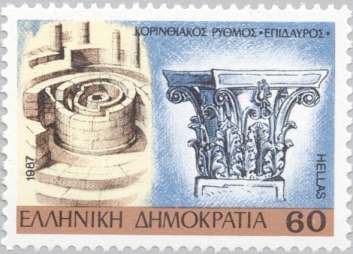.
The third order, called Corinthian, is an imitation of the slenderness of a maiden; for the outlines and limbs of maidens, being more slender on account of their tender years, admit of prettier effect in the way of adornment.
It is related that the original discovery of this form of capital was as follows. A freeborn maiden of Corinth, just of marriageable age, was attacked by an illness and passed away. After her burial, her nurse, collecting a few little things which used to give the girl pleasure while she was alive, put them in a basket, carried it to the tomb, and laid it on top thereof, covering it with a roof-tile so that the things might last longer in the open air. This basket happened to be placed just above the root of an acanthus. The acanthus root, pressed down meanwhile though it was by the weight, when springtime came round put forth leaves and stalks in the middle, and the stalks, growing up along the sides of the basket, and pressed out by the corners of the tile through the compulsion of its weight, were forced to bend into volutes at the outer edges. Just then Callimachus ... passed by this tomb and observed the basket with the tender young leaves growing round it. Delighted with the novel style and form, he built some columns after that pattern for the Corinthians, determined their symmetrical proportions, and established from that time forth the rules to be followed in finished works of the Corinthian order. Vitruvius

Callimachus Inspiration of the Corinthian Order. A basket on an acanthus.
The Corinthian Order is similar to the Ionic Order, with the exception of the capital decorated usually with 2 tiers of acanthus leaves, and anthemion ornaments. The first known use of the Corinthian order was in Athens around 335 BC (Lysicrates Choragic Monument, with only one tier of acanthus leaves). Earlier it was used in the Apollo Epicurius Temple, Bassae c. 430/390 BC. It was used mainly in the Hellenistic period and by the Romans.
Image of the Invention of the Corinthian Order (Callimachus is on the left side near the tomb)
Details from Vitruvius and Comments

(Epidaurus Example) a late fifth-century innovation (Acanthus leaves)
While we look upward at this group of temples and their wealth of sculptures, let us state now something we have noticed during all our walks around Athens, but have hitherto left without comment. Every temple and statue in Athens is not left in its bare white marble, as later ages will conceive is demanded by "Greek Architecture" and statuary, but is decked in brilliant color--"painted," if you will use an almost unfriendly word. The columns and gables and ceilings of the buildings are all painted. Blue, red, green, and gold blaze on all the members and ornaments. The backgrounds of the pediments, metopes, and frieze are tinted some uniform color on which the sculptured figures in relief stand out clearly. The figures themselves are tinted or painted, at least on the hair, lips, and eyes. Flesh-colored warriors are fighting upon a bright red background. The armor and horse trappings on the sculptures are in actual bronze. The result is an effect indescribably vivid. Blues and reds predominate: the flush of light and color from the still more brilliant heavens above adds to the effect. Shall we call it garish? We have learned to know the taste of Athenians too well to doubt their judgment in matters of pure beauty. And they are right. UNDER AN ATHENIAN SKY temples and statues demand a wealth of color which in a somber clime would seem intolerable. The brilliant lines of the Acropolis buildings are the just answer of the Athenian to the brilliancy of Helios. William Stearns Davis A Day in Old Athens

One of various color reconstructions. Decorative elements: Two tiers of Acanthus leaves, spiroidal volutes and at the center top the anthemion (honeysuckle motif)
Corinthian Order
| Ancient Greece
Science, Technology , Medicine , Warfare, , Biographies , Life , Cities/Places/Maps , Arts , Literature , Philosophy ,Olympics, Mythology , History , Images Medieval Greece / Byzantine Empire Science, Technology, Arts, , Warfare , Literature, Biographies, Icons, History Modern Greece Cities, Islands, Regions, Fauna/Flora ,Biographies , History , Warfare, Science/Technology, Literature, Music , Arts , Film/Actors , Sport , Fashion --- |
Retrieved from "http://en.wikipedia.org/"
All text is available under the terms of the GNU Free Documentation License

